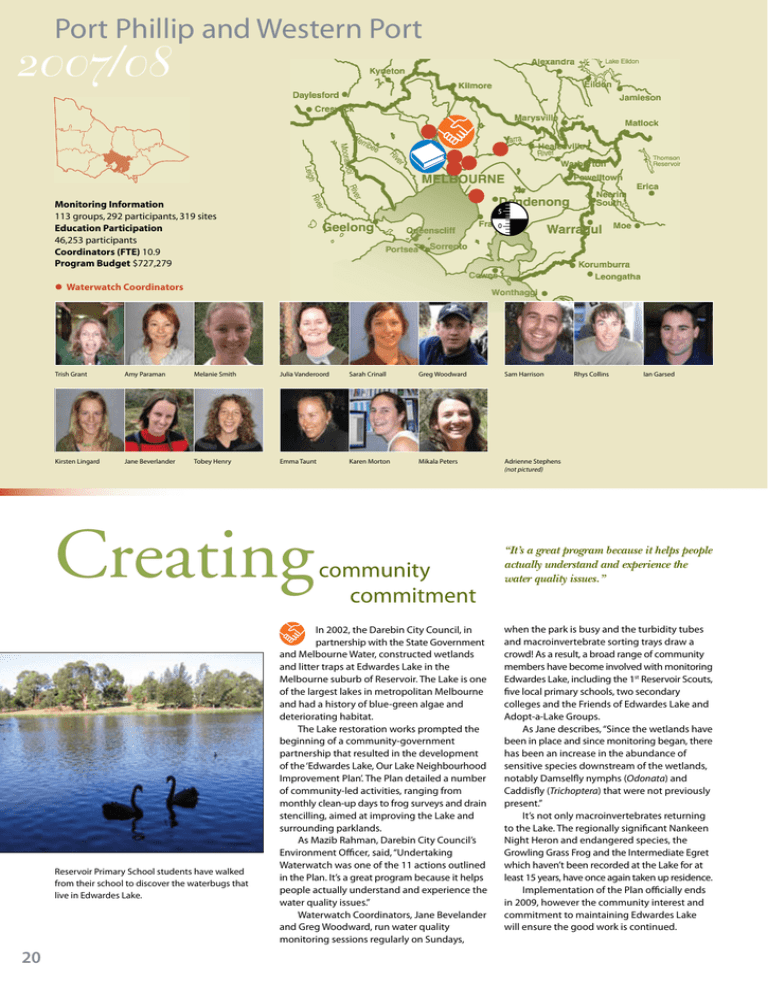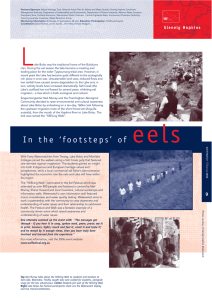2007/08 Port Phillip and Western Port
advertisement

Port Phillip and Western Port 2007/08 Monitoring Information 113 groups, 292 participants, 319 sites Education Participation 46,253 participants Coordinators (FTE) 10.9 Program Budget $727,279 • Waterwatch Coordinators Trish Grant Amy Paraman Melanie Smith Julia Vanderoord Sarah Crinall Greg Woodward Sam Harrison Kirsten Lingard Jane Beverlander Tobey Henry Emma Taunt Karen Morton Mikala Peters Adrienne Stephens (not pictured) Creating Reservoir Primary School students have walked from their school to discover the waterbugs that live in Edwardes Lake. 20 community commitment In 2002, the Darebin City Council, in partnership with the State Government and Melbourne Water, constructed wetlands and litter traps at Edwardes Lake in the Melbourne suburb of Reservoir. The Lake is one of the largest lakes in metropolitan Melbourne and had a history of blue-green algae and deteriorating habitat. The Lake restoration works prompted the beginning of a community-government partnership that resulted in the development of the ‘Edwardes Lake, Our Lake Neighbourhood Improvement Plan’. The Plan detailed a number of community-led activities, ranging from monthly clean-up days to frog surveys and drain stencilling, aimed at improving the Lake and surrounding parklands. As Mazib Rahman, Darebin City Council’s Environment Officer, said, “Undertaking Waterwatch was one of the 11 actions outlined in the Plan. It’s a great program because it helps people actually understand and experience the water quality issues.” Waterwatch Coordinators, Jane Bevelander and Greg Woodward, run water quality monitoring sessions regularly on Sundays, Rhys Collins Ian Garsed “It’s a great program because it helps people actually understand and experience the water quality issues.” when the park is busy and the turbidity tubes and macroinvertebrate sorting trays draw a crowd! As a result, a broad range of community members have become involved with monitoring Edwardes Lake, including the 1st Reservoir Scouts, five local primary schools, two secondary colleges and the Friends of Edwardes Lake and Adopt-a-Lake Groups. As Jane describes, “Since the wetlands have been in place and since monitoring began, there has been an increase in the abundance of sensitive species downstream of the wetlands, notably Damselfly nymphs (Odonata) and Caddisfly (Trichoptera) that were not previously present.” It’s not only macroinvertebrates returning to the Lake. The regionally significant Nankeen Night Heron and endangered species, the Growling Grass Frog and the Intermediate Egret which haven’t been recorded at the Lake for at least 15 years, have once again taken up residence. Implementation of the Plan officially ends in 2009, however the community interest and commitment to maintaining Edwardes Lake will ensure the good work is continued. “We wanted students to be even more hands-on and more interactive amongst themselves, giving them space to learn from each other.” Inspired learning How do you keep students occupied and attentive, and cope with different learning styles and language barriers in the classroom? Port Phillip and Westernport Waterwatch Coordinators Sarah Crinall and Tobey Henry found a way, by looking beyond traditional science teaching methods to another hands-on activity, courtesy of the world of visual art! By introducing various forms of art, their students were soon modelling macroinvertebrates from plasticine and clay, taking photographs, creating paper collages of water mites, ‘drawing’ erosion, mapping the movement of water beetles and painting with bark and leaves. Sarah describes, “If you had the perfect child, their undivided attention and three hours, you could explain the biology and science … but in reality you have a classroom of energetic students and one hour. By introducing art, they create something, they notice the detail and they learn through that detail.” Tobey adds, “We wanted students to be even more hands-on and more interactive amongst themselves, giving them space to learn from each other, notice the finer details and begin to understand the science in a way that made sense to them.” One student, reflecting on the art activity, said that she had enjoyed it because she could draw things that she didn’t know how to explain in writing. Tobey said, “It’s very hard to achieve a perfect line with an imperfect twig as a quill!” Taking away the need for perfect, finished pieces of art, students quickly honed in on what interested them. A further outcome of using art as part of the program has been the creation of a ‘take home message.’ Sarah reflects that coordinators constantly seek ways for students to share what they have learnt with their family and what better way than by presenting them with a delicate ink and twig sketch of a damselfly nymph or a bright plasticine frog! Macroinvertebrates modelled out of clay and decorated with leaves and twigs. Gearing up in the coastal villages Monitors Mary and Sharon’s first task was to select monitoring sites. “The group aims to raise local awareness about the importance of nutrient management.” In the stretch of coastline between the townships of Tooradin and Warneet, numerous creeks feed into small estuarine inlets and ultimately Western Port Bay. At the beginning of 2008, some members of the coastal village became concerned about the water quality in the creeks. As member Mary Madigan describes, “We have a creek at the bottom of our property and there were lots of frogs there, but not now. It made me wonder about the water quality.” To find out more, Mary and some friends went to a Waterwatch training day, held at The Briars in Mount Martha. Keen to apply what they had learnt at the training day, local Waterwatch Coordinator Amy Paraman assisted the group members to choose monitoring sites and develop a monitoring program. As Amy explained, “The group was concerned about nutrient run-off in the area, so their monitoring is focused on the phosphorus and turbidity.” The group, which is supported by the City of Casey and Melbourne Water, officially began regular monitoring at five sites in April. Amy is hopeful that once the group’s monitoring program is well established other people living in the coastal villages along Western Port Bay will get involved to form a network. Mary explains the benefits of a broader network, “If locals understand the implications of taking care of our creeks and watercourses they are more likely to be careful about how they treat them. Water is precious and we must value every drop.” Ultimately, the group aims to raise local awareness about the importance of nutrient management and hopes to contribute publicly accessible data to the City of Casey’s website. Partners and Sponsors of the Port Phillip and Western Port Waterwatch Program Melbourne Water, Natural Heritage Trust, Department of Sustainability and Environment, Department of Primary Industries, Merri Creek Management Committee, Banyule City Council, Baw Baw Shire Council, Boroondara City Council, Brimbank City Council, Cardinia Shire Council, Casey City Council, Darebin City Council, Frankston City Council, Greater Dandenong City Council, Hobsons Bay City Council, Hume City Council, Kingston City Council, Knox City Council, Manningham City Council, Maribyrnong City Council, Maroondah City Council, Melbourne City Council, Melton City Council, Monash City Council, Moonee Valley City Council, Moorabool Shire Council, Moreland City Council, Mornington Peninsula Shire Council, Nillumbik Shire Council, Stonnington City Council, Whitehorse City Council, Whittlesea City Council, Wyndham City Council, Yarra City Council, Shire of Yarra Ranges, Nestle, Port Phillip and Western Port Catchment Management Authority. 21





